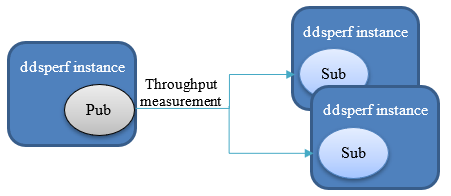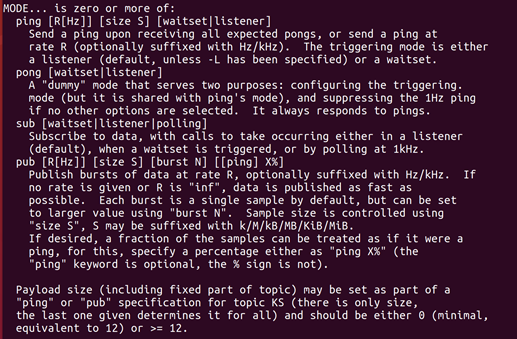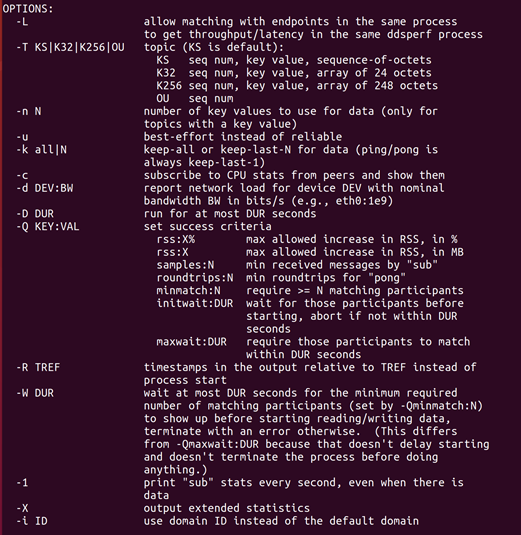Benchmarking Tools¶
Introduction¶
Cyclone DDS provides a tool that primarily measures data throughput
and latency of the DDS applications within the network or
within the same board, namely ddsperf. This tool also helps
sanity checks to ensure your configuration is correctly set up and
running. This chapter describes how to use the ddsperf tool and
read and interpret its outputs and results. Using the Cyclone DDS Python
package, you can also run ddsperf as a graphical application, by running
cyclonedds performance.
As well as ddsperf, you can find dedicated examples in the
product distribution that measure the DDS system throughput and the
latency with their associated codebase. You can start from the provided
code and customize it to fit your scenario and exact data types. Both the
ddsperf tool and the provided examples perform the benchmarking using
sequences of octets with different parameterized sizes.
Important
The throughput and latency examples are not suitable as general
DDS benchmarking tools since they sacrifice performance for being as simple
as possible. You cannot compare test results from these tools with results from other tools.
Testing your network configuration¶
Once your Cyclone DDS installation is successfully completed, you may
want to test if your network environment is correctly set up. This can
be done by running the Hello World! example or using the
ddsperf tool. The Hello World! example sends a single message.
In contrast, the ddsperf tool can send a continuous stream of data at a
variable frequency for sanity checks and bypass sporadic network issues.
The ddsperf tool is pre-installed within <installation-dir>/bin.
Complete the sanity checks of your DDS based system using the ddsperf
tool as follows:
ddsperf sanity
The sanity option sends only one data sample each second (1Hz).
In another terminal, start the ddsperf with the Pong mode to echo
the data to the first instance of the ddsperf started with the
Sanity option.
ddsperf pong

If the data is not exchanged on the network between the two ddsperf instances, it is likely that Eclipse Cyclone DDS has not selected the the appropriate network card on both machines or a firewall in-between is preventing communication.
Eclipse Cyclone DDS automatically selects the most available network interface. This behavior can be overridden by changing the configuration file. (see section test your installation for more details) .
When running the previous scenario on a local machine, this test ensures the loop-back option is enabled.
Measuring latency¶
To measure latency between two different applications, you need to run
two instances of the ddsperf tool and instruct one of them to endorse
the role of a sender that sends a given amount of data (a sequence of
octets) at a given rate, and the other instance takes the role of
receiver that sends back the same amount of data to the sender in a
Ping-Pong scenario. The sending action is triggered by the Ping
option. The receiving behavior is triggered by the Pong action. The
sender measures the roundtrip time and computes the latency as half of
the roundtrip time.
The Ping-Pong scenario avoids clock desynchronization issues that might occur between two machines that do not accurately share the same perception of the time in the network.

To differentiate the two operational modes, the ddsperf tool can
operate either in a Ping mode or in a Pong mode.
To run this scenario, open two terminals (e.g., on Linux-like OSs) and run the following commands in either of the terminals. The graphical python-based alternative is also noted.
ddsperf ping
cyclonedds performance ping
Input this command in another terminal:
ddsperf pong
cyclonedds performance pong
This basic scenario performs a simple latency test with all the default values. You may customize your test scenario by changing the following options.
In Ping mode you can specify:
The Rate and frequency at which data is written. This is specified through the [R[Hz]] option. The default rate is “as fast as possible”. In ping mode, it always sends a new ping as soon as it gets a pong
The Size of the data that is exchanged. This is specified through the [Size S] option. Using the built-in default topic, 12 bytes (an integer key, an integer sequence number, and an empty sequence of bytes) are sent every time. The size is “as small as possible” by default, depending on the default topic size.
The Listening mode, which can either be
waitsetbased orListenerCallbacks modes. In the waitset mode theddsperfapplication creates a dedicated thread to wait for the data to return back from the receiving instance ofddsperftool (i.e the instance started with the Pong mode). In the Listener Callback mode, the thread is created by the Eclipse Cyclone DDS middleware. The Listener mode is the default.
In Pong mode,you can only specify one option:
The Listening mode (with two possible values,
waitsetorListener)
For instance, if you want to measure local latency between to processes exchanging 2KB at the frequency of 50Hz, you can run the following commands in 2 different terminals:
ddsperf ping 50Hz 2048 waitset
cyclonedds performance ping --rate 50Hz --size 2048 --triggering-mode waitset
ddsperf pong waitset
cyclonedds performance pong --triggering-mode waitset
The output of the ddsperf tool is as shown below:
The output for the Ping application indicates mainly:
The size of the data involved in the test (e.g. 12 bytes)
The minimum latency (e.g. 78.89 us)
The maximum latency (e.g. 544,85 us)
The mean latency (e.g. 118.434 us)
As well as the latency at 50%, 90%, or 99% of the time.

The output for the Pong application:
RSS is the Resident Set Size; it indicates the amount of memory used by the process (e.g. 3.5MB used by the process id 2680);
VCSW is the number of voluntary switches, it indicates the times when the process waits for input or an event (e.g. 2097 times);
IVCSW is the number of involuntary switches, it indicates the times when the process is pre-empted or blocked by a mutex (e.g. 6 times);
The percentage of time spent executing user code and the percentage of time spent executing the kernel code in a specific thread (e.g. spent almost 0% of the time executing the user code and 5% executing kernel code in thread “ping”).

Measuring throughput¶
To measure throughput between two different applications, you need to
run at least two instances of the ddsperftool and instruct one of
them to endorse the role of a Publisher that sends a given amount of
data (a sequence of octets) at a given rate. The other instances take
the role of Subscriber applications.
Note: When your scenario involves only one subscriber, the UDP unicast mode is used. If several subscriber instances are running, the multicast is automatically used.

Two additional modes are therefore supported:
The Pub mode and the Sub mode.
In the Sub mode, the subscriber operates either:
Using the Listener notification mechanism,
The WaitSet notification mechanism, or
The Pooling mode. The pooling mode allows the subscriber to cyclically fetch the data from its local cache instead of being notified each time a new set of data is added to the subscriber’s cache as is the case with the other modes.
You can publish data in two ways by publishing each data sample individually or by sending them in a Burst mode.
The Rate and frequency at which data is written. This is specified through the [R[Hz]] option. The default rate is “as fast as possible”. This means, in pub mode, instead of trying to reach a certain rate, it just pushes data as hard as it can.
The Size of the data that is exchanged. This is specified through the [Size S] option. The size is “as small as possible” by default, depending on the size of the topic it defaults to.
The Burst Size , defines the number of data samples issued together as a batch. This parameter is defined by the [Burst N] option. The default size for burst is 1. It doesn’t make much difference when going “as fast as possible”, and it only applies to the pub mode.
The triggering mode by default is listener for the ping , pong and sub mode.
To run a simple throughput test, you can simply run a pub mode and a sub mode in 2 different terminals without specifying any other options or you can customize it as shown below:
Open two terminals, navigate to the directory where ddsperf is located
and write the following command:
ddsperf pub size 1k
cyclonedds performance publish --size 1k
And in the other terminal, type in:
ddsperf -Qrss:1 sub
cyclonedds performance -Qrss:1 subscribe
This measures the throughput of data samples with 1Kbytes written as fast as possible.
The -Qrss:1 option in sub mode sets the maximum allowed an increase
in RSS as 1MB. When running the test, if the memory occupied by the
process increases by less than 1MB, the test can successfully run.
Otherwise, an error message is printed out at the end of the test.
As the pub in this example only has a size of 1k, the sub does not
print out an RSS error message at the end of the test.
The output of the ddsperf tool when measuring throughput is as shown
below:
The output for the Pub application indicates mainly:
RSS is the Resident Set Size; it indicates the amount of memory is used by the process (e.g. 6.3MB used by the process id “4026”);
VCSW is the number of voluntary switches, it indicates the times when the process waits for input or an event (e.g. 1054 times);
IVCSW is the number of involuntary switches, it indicates the times when the process is pre-empted or blocked by a mutex (e.g. 24 times);
The percentage of time spent executing user code and the percentage of time spent executing kernel code in a specific thread (e.g. spent 34% of the time executing the user code and 11% executing kernel code in thread “pub”).

The output for the Sub application indicates mainly:
The size of the data involved in this test (e.g. 1024 bytes, which is the “size 1k” defined in the pub command)
The total packets received (e.g. 614598);
The total packets lost t (e.g. 0);
The packets received in a 1 second reporting period (e.g. 212648);
The packets lost in a 1 second report period (e.g. 0);
The number of samples processed by the Sub application in 1s (e.g. 21260 KS/s, with the unit KS/s is 1000 samples per second).

Measuring Throughput and Latency in a mixed scenario¶
In some scenarios, it might be helpful to measure the throughput and latency at the same time.
The ddsperf tool allows you to mix these two scenarios.
The Ping mode can be combined with the Pub mode to address such cases.
The [Ping x%] switch combined with the Pub mode allows you to send a fraction of samples x% as if they were used in the Ping mode.
The different modes of the ddsperf tool are summarized in the figure
below.

You can get more information for the ddsperf tool by using the [help]
option:
ddsperf help
cyclonedds performance --help
Additional options¶
As well as selecting the mode, you can also select the options
to specify how to send and receive the data (such as modifying the
reliable QoS from Reliable to Best-Effort with the -u option), or
how to evaluate or view the data in the ddsperftool.
The options you can select are listed in the ddsperf help
menu, as shown below.
